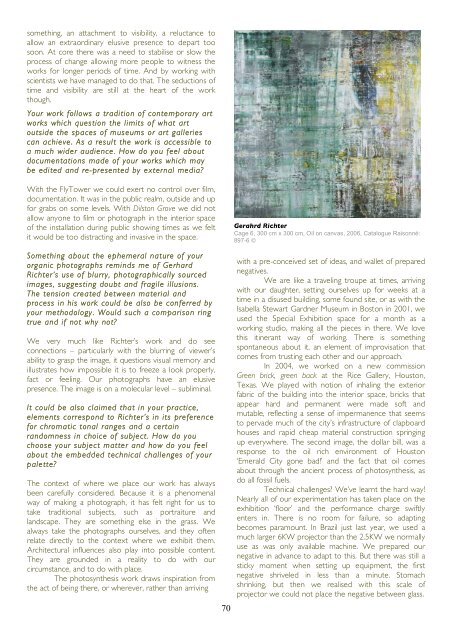M - Antennae The Journal of Nature in Visual Culture
M - Antennae The Journal of Nature in Visual Culture
M - Antennae The Journal of Nature in Visual Culture
Create successful ePaper yourself
Turn your PDF publications into a flip-book with our unique Google optimized e-Paper software.
someth<strong>in</strong>g, an attachment to visibility, a reluctance to<br />
allow an extraord<strong>in</strong>ary elusive presence to depart too<br />
soon. At core there was a need to stabilise or slow the<br />
process <strong>of</strong> change allow<strong>in</strong>g more people to witness the<br />
works for longer periods <strong>of</strong> time. And by work<strong>in</strong>g with<br />
scientists we have managed to do that. <strong>The</strong> seductions <strong>of</strong><br />
time and visibility are still at the heart <strong>of</strong> the work<br />
though.<br />
Your work follows a tradition <strong>of</strong> contemporary art<br />
works which question the limits <strong>of</strong> what art<br />
outside the spaces <strong>of</strong> museums or art galleries<br />
can achieve. As a result the work is accessible to<br />
a much wider audience. How do you feel about<br />
documentations made <strong>of</strong> your works which may<br />
be edited and re-presented by external media?<br />
With the FlyTower we could exert no control over film,<br />
documentation. It was <strong>in</strong> the public realm, outside and up<br />
for grabs on some levels. With Dilston Grove we did not<br />
allow anyone to film or photograph <strong>in</strong> the <strong>in</strong>terior space<br />
<strong>of</strong> the <strong>in</strong>stallation dur<strong>in</strong>g public show<strong>in</strong>g times as we felt<br />
it would be too distract<strong>in</strong>g and <strong>in</strong>vasive <strong>in</strong> the space.<br />
Someth<strong>in</strong>g about the ephemeral nature <strong>of</strong> your<br />
organic photographs rem<strong>in</strong>ds me <strong>of</strong> Gerhard<br />
Richter’s use <strong>of</strong> blurry, photographically sourced<br />
images, suggest<strong>in</strong>g doubt and fragile illusions.<br />
<strong>The</strong> tension created between material and<br />
process <strong>in</strong> his work could be also be conferred by<br />
your methodology. Would such a comparison r<strong>in</strong>g<br />
true and if not why not?<br />
We very much like Richter’s work and do see<br />
connections – particularly with the blurr<strong>in</strong>g <strong>of</strong> viewer’s<br />
ability to grasp the image, it questions visual memory and<br />
illustrates how impossible it is to freeze a look properly,<br />
fact or feel<strong>in</strong>g. Our photographs have an elusive<br />
presence. <strong>The</strong> image is on a molecular level – sublim<strong>in</strong>al.<br />
It could be also claimed that <strong>in</strong> your practice,<br />
elements correspond to Richter’s <strong>in</strong> its preference<br />
for chromatic tonal ranges and a certa<strong>in</strong><br />
randomness <strong>in</strong> choice <strong>of</strong> subject. How do you<br />
choose your subject matter and how do you feel<br />
about the embedded technical challenges <strong>of</strong> your<br />
palette?<br />
<strong>The</strong> context <strong>of</strong> where we place our work has always<br />
been carefully considered. Because it is a phenomenal<br />
way <strong>of</strong> mak<strong>in</strong>g a photograph, it has felt right for us to<br />
take traditional subjects, such as portraiture and<br />
landscape. <strong>The</strong>y are someth<strong>in</strong>g else <strong>in</strong> the grass. We<br />
always take the photographs ourselves, and they <strong>of</strong>ten<br />
relate directly to the context where we exhibit them.<br />
Architectural <strong>in</strong>fluences also play <strong>in</strong>to possible content.<br />
<strong>The</strong>y are grounded <strong>in</strong> a reality to do with our<br />
circumstance, and to do with place.<br />
<strong>The</strong> photosynthesis work draws <strong>in</strong>spiration from<br />
the act <strong>of</strong> be<strong>in</strong>g there, or wherever, rather than arriv<strong>in</strong>g<br />
70<br />
Gerahrd Richter<br />
Cage 6, 300 cm x 300 cm, Oil on canvas, 2006, Catalogue Raisonné:<br />
897-6 �<br />
with a pre-conceived set <strong>of</strong> ideas, and wallet <strong>of</strong> prepared<br />
negatives.<br />
We are like a travel<strong>in</strong>g troupe at times, arriv<strong>in</strong>g<br />
with our daughter, sett<strong>in</strong>g ourselves up for weeks at a<br />
time <strong>in</strong> a disused build<strong>in</strong>g, some found site, or as with the<br />
Isabella Stewart Gardner Museum <strong>in</strong> Boston <strong>in</strong> 2001, we<br />
used the Special Exhibition space for a month as a<br />
work<strong>in</strong>g studio, mak<strong>in</strong>g all the pieces <strong>in</strong> there. We love<br />
this it<strong>in</strong>erant way <strong>of</strong> work<strong>in</strong>g. <strong>The</strong>re is someth<strong>in</strong>g<br />
spontaneous about it, an element <strong>of</strong> improvisation that<br />
comes from trust<strong>in</strong>g each other and our approach.<br />
In 2004, we worked on a new commission<br />
Green brick, green back at the Rice Gallery, Houston,<br />
Texas. We played with notion <strong>of</strong> <strong>in</strong>hal<strong>in</strong>g the exterior<br />
fabric <strong>of</strong> the build<strong>in</strong>g <strong>in</strong>to the <strong>in</strong>terior space, bricks that<br />
appear hard and permanent were made s<strong>of</strong>t and<br />
mutable, reflect<strong>in</strong>g a sense <strong>of</strong> impermanence that seems<br />
to pervade much <strong>of</strong> the city’s <strong>in</strong>frastructure <strong>of</strong> clapboard<br />
houses and rapid cheap material construction spr<strong>in</strong>g<strong>in</strong>g<br />
up everywhere. <strong>The</strong> second image, the dollar bill, was a<br />
response to the oil rich environment <strong>of</strong> Houston<br />
‘Emerald City gone bad!’ and the fact that oil comes<br />
about through the ancient process <strong>of</strong> photosynthesis, as<br />
do all fossil fuels.<br />
Technical challenges? We’ve learnt the hard way!<br />
Nearly all <strong>of</strong> our experimentation has taken place on the<br />
exhibition ‘floor’ and the performance charge swiftly<br />
enters <strong>in</strong>. <strong>The</strong>re is no room for failure, so adapt<strong>in</strong>g<br />
becomes paramount. In Brazil just last year, we used a<br />
much larger 6KW projector than the 2.5KW we normally<br />
use as was only available mach<strong>in</strong>e. We prepared our<br />
negative <strong>in</strong> advance to adapt to this. But there was still a<br />
sticky moment when sett<strong>in</strong>g up equipment, the first<br />
negative shriveled <strong>in</strong> less than a m<strong>in</strong>ute. Stomach<br />
shr<strong>in</strong>k<strong>in</strong>g, but then we realised with this scale <strong>of</strong><br />
projector we could not place the negative between glass.












